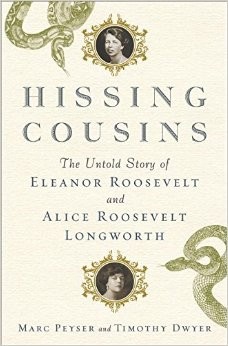Hissing Cousins tells the story of the two most famous women in the Roosevelt dynasty, Eleanor Roosevelt and Alice Roosevelt Longworth. Born in 1884, they were first cousins: Eleanor's father was Elliott Roosevelt; Alice's father was Elliott's famous brother, Theodore. After growing up together in New York City in a beribboned haze of privilege, they ventured toward womanhood along very different paths. Eleanor, a progressive Democrat, married Franklin Delano Roosevelt (from the family's Hyde Park branch). Alice, a staunch Republican, married Ohio Senator Nicholas Longworth.
As the authors tell it, each woman became a political force and a public figure in her own right, and each made the cover of Time. In the 1930s they were dubbed "Mrs. Democrat and Mrs. Republican," and penned columns attacking each other's beliefs and political parties. Then they'd meet for dinner at the White House.
If you're a fan of biographies and American history, there's much to enjoy here. This is an easy, armchair read about a fascinating time, peppered with chuckle-worthy political trivia. Apparently, a single remark from Alice (known for her damning, powerful barbs) derailed the Republican presidential candidacy of Thomas Dewey: She called him "the little man on the wedding cake." The authors trot out poor Dewey again when Eleanor (then Mrs. Roosevelt) protests to reporter Lorena Hickok that she's a boring subject. "In the world of dead-wrong political predictions, Eleanor's was right up there with Dewey Defeats Truman," the authors write. Got it.
It can be a certain relief when a book renders characters in such broad strokes that you don't have to squint to see them. But there's something underdone in the telling. By never allowing each woman enough time outside the Great Rivalry, neither takes full shape. Yet clearly, there was a lot more going on than this relationship.
The women seem crowded by a revolving door of big men. Husbands, public figures, and candidates loom in every corner, philandering, wheeling and dealing, somehow more accessibly drawn. Granted, Alice and Eleanor were women operating in a man's world, but this is their story. One keeps expecting the authors to take a stand for them, to conjecture boldly on their motivations and inner lives. But the authorial stance is never to go out on a speculative limb. When Alice skips Eleanor's funeral, the authors venture, "Some wondered if it was a parting shot," but add that by then, she and Eleanor weren't really attacking each other anymore anyway.
We do learn that it is not impossible that Alice had her own designs on FDR, which Eleanor probably knew about. And (though it's hardly unknown) that Eleanor and Lorena Hickok exchanged passionate, intimate letters for years. Still, the authors equivocate. Eleanor was certainly mad at Alice for boinking her husband, but do we really know that that contributed to their political animosity? And while the rest of the modern world may assume Hickok and Eleanor were lovers, the authors put the brakes on, though they don't dismiss the possibility.
Such a noncommittal stance may be intended to do justice to these women, rather than confine them within labels. But by not delving more deeply into the psyche and emotional life of each woman, the deeper her-story remains untold. Eleanor remains noble, Alice remains sharp-tongued. Neither rises from the pages into a living, breathing, three-dimensional character. They remain figureheads. But that may be to their relief. Appearing 4/11 at 7pm, Oblong Books & Music, Rhinebeck.
—Jana Martin













